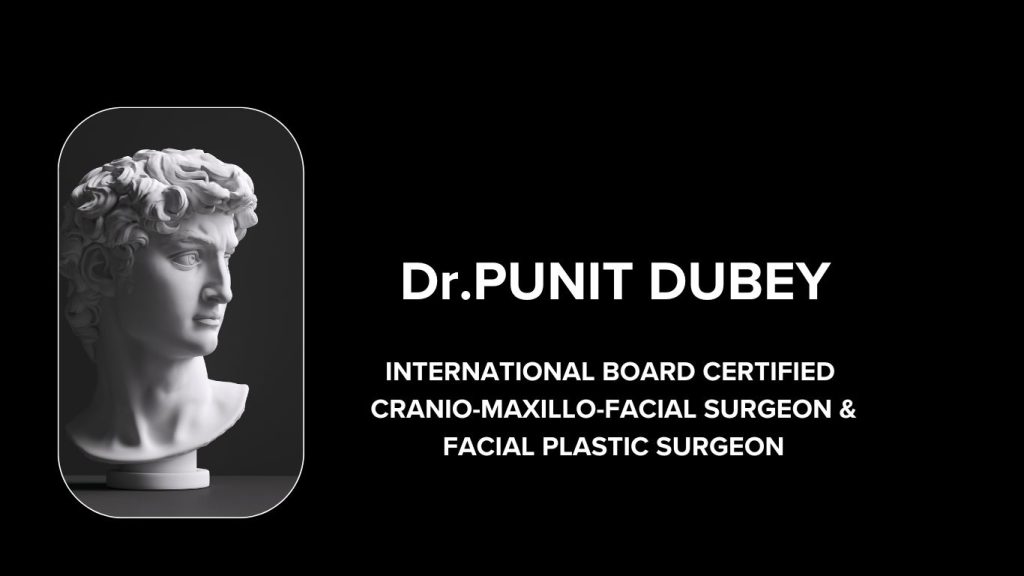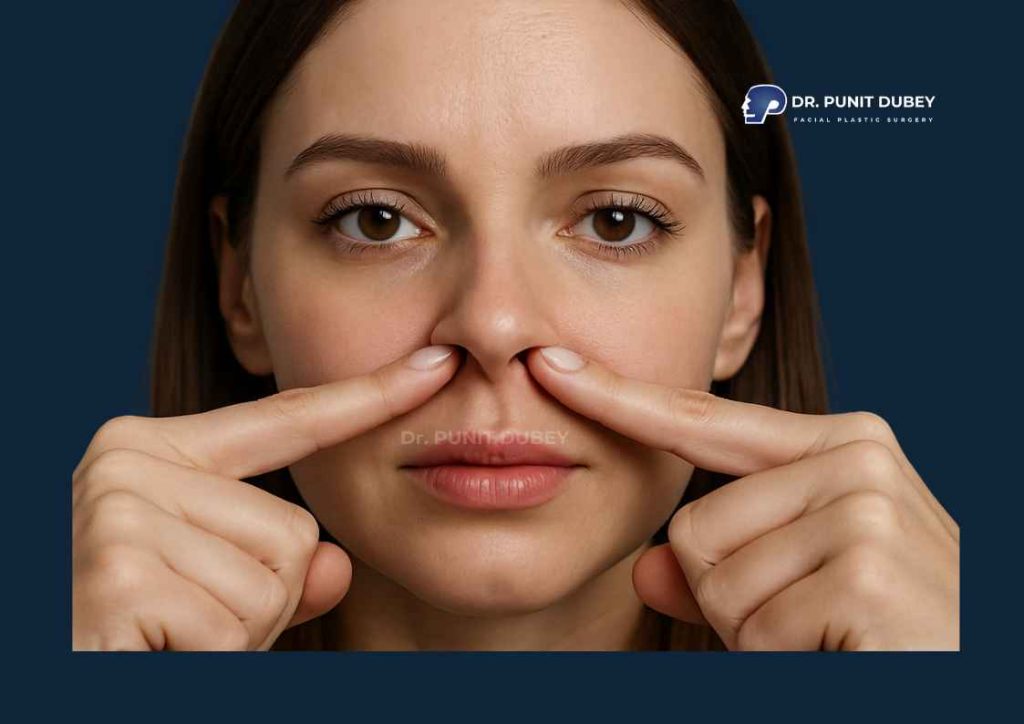
Alarplasty in Delhi, India
If you’re self-conscious about flared nostrils or the wide base of your nose, you’re not alone — and you’re not out of options. Alarplasty in Delhi is a precise, minimally invasive procedure designed to reshape the base of your nose (also known as the alar) for a more balanced, refined facial appearance. Whether you’re aiming to reduce nostril width, enhance nasal symmetry, or pair this with a rhinoplasty for comprehensive reshaping, alarplasty surgery can deliver transformative, natural-looking results.
In this detailed guide, we’ll walk you through everything — from what alarplasty actually means to how it’s performed, recovery tips, before-and-after photos, costs in Delhi and across India, and why Dr. Punit Dubey is increasingly recognized as a leading expert in alarplasty procedures across India, known for delivering refined, natural-looking results.
Table of Contents
What is Alarplasty?
Alarplasty, often referred to as nostril or alar base reduction, is a cosmetic procedure designed to narrow and reshape the outer portion of the nostrils — the part known as the alar or nasal wings. This surgery narrows a wide nasal base and reduces nostril flare, creating a more proportionate and aesthetically pleasing nose.
It’s important to distinguish alarplasty from rhinoplasty. While rhinoplasty reshapes the internal nasal structure, alarplasty addresses the outer edges of the nostrils, making it an excellent choice for patients who want refinement without undergoing full rhinoplasty.
How is Alarplasty Done?
During the procedure:
- A minimal section of tissue is excised from the junction of the nostrils and cheeks to reduce nostril flare.
- After tissue removal, the area is carefully sculpted and sutured to preserve balance and natural nasal shape.
- The incisions are typically placed in natural creases, making alarplasty scars well-hidden once healed.
The technique can be customized based on your nasal anatomy, goals, and symmetry needs. It can also be done as a standalone surgery or in combination with tip plasty or rhinoplasty for a comprehensive transformation.
What Does Alarplasty Treat?
Alarplasty is ideal for those who:
- Experience prominent nostril flare or a broadened nasal foundation.
- Have asymmetrical nostrils
- Whether you’re seeking a cosmetic refinement or correcting a structural issue, reduce nostril size can be effectively achieved through alarplasty.
- Have ethnic noses with broader alar wings and desire refinement without losing ethnic identity
Feel dissatisfied with how their nose tip or lower nasal structure looks following an earlier nose surgery.
Think of alarplasty as a tailor’s touch — subtle, precise trimming of the “fabric” of your nose that can redefine your entire facial symmetry.
Understanding Wide Nose
A wide nose, especially one with a broad nasal base or flared nostrils, can significantly influence the overall balance of your facial features. While wide noses are often genetic or ethnically influenced, many individuals feel that a broader nose doesn’t harmonize with the rest of their facial proportions — especially in close-up photos or side profiles.
But here’s the thing: having a wide nose doesn’t mean something is wrong. It simply means that you might benefit from refinement — not a complete change.
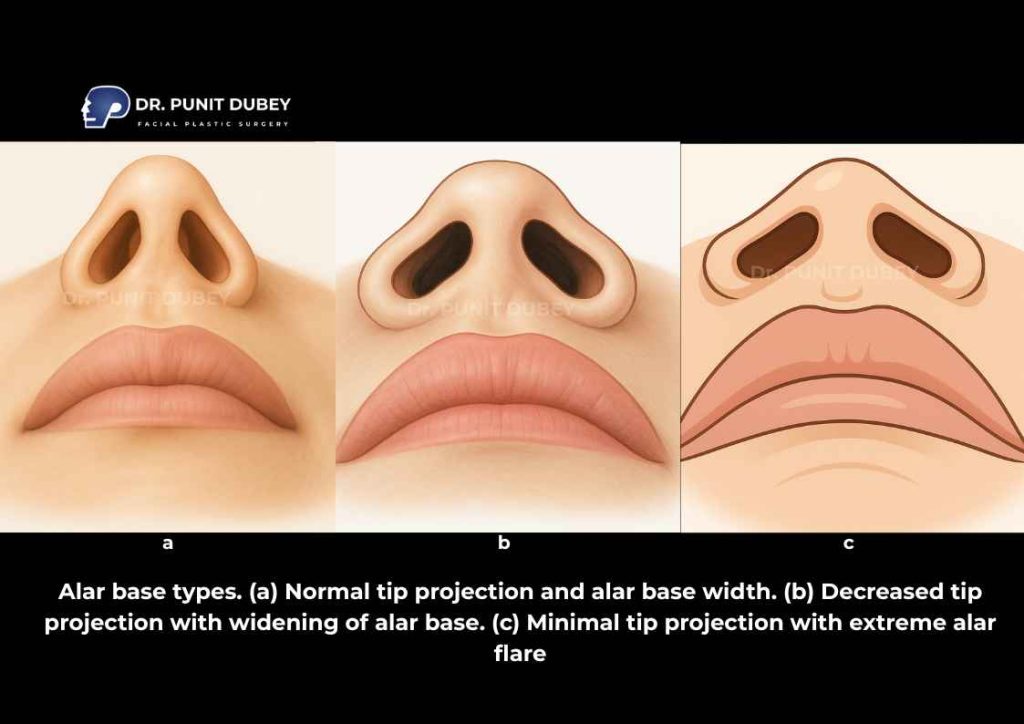
What Makes a Nose “Wide”?
Several anatomical factors contribute to the appearance of a wide nose:
- Wide Alar Base: The outer edges of the nostrils (known as the alae) are positioned farther apart.
- Nasal Flare: The nostrils expand or flare outwards when smiling or talking.
- Bulbous Tip: A thick or rounded nasal tip can make the entire base look disproportionately broad.
- Thick Nasal Skin: Common in certain ethnic groups, it may make the nose appear broader.
- A low or short nasal bridge can make the base of the nose appear wider than it actually is, drawing more attention to the nostrils.
Aesthetic Impact of a Wide Nose
While beauty is incredibly subjective, balance and proportion play a key role in how facial features are perceived. A wide nose may:
- Distract from the eyes or lips
- Make the midface look broader or heavier
- Create asymmetry when paired with uneven nostrils
That’s where alarplasty or alar base reduction surgery comes into play — by refining the base of the nose to bring better harmony to the overall facial structure.
Alarplasty in Wide Nose
If your nose feels disproportionately wide — especially across the nostril base — then alarplasty is one of the most effective solutions to bring subtle yet powerful change. This surgery focuses specifically on the alar base, which is the soft outer portion of the nostrils. When widened, this area can create the appearance of an enlarged nose, even if the bridge and tip are well-defined.
Alarplasty for a wide nose helps you achieve:
- Narrower nostrils
- Less flaring during expressions like smiling or laughing
- Creates a cleaner, well-proportioned appearance by bringing symmetry to the nose and face.
But here’s where things get more interesting: alarplasty isn’t one-size-fits-all. Depending on your nasal anatomy, skin thickness, and overall goals, it may be combined with other procedures like rhinoplasty or tip refinement for optimal results.
Correcting a Broad Nose: Cases That Require More Than Just Alarplasty
In cases where nasal width is due to internal cartilage or bone (rather than just flared nostrils), a wide nose rhinoplasty may be required. This includes:
- Osteotomies (controlled bone cuts) to narrow the bridge
- Refining the cartilage at the tip helps improve the nose’s definition and adds a more sculpted finish.
- Possible septoplasty if breathing issues coexist
This is often combined with alarplasty to achieve both internal correction and external refinement.
Bulbous Nose Rhinoplasty vs. Alarplasty
Uncertain whether the broadness of your nose comes from the nostril width or the tip’s shape? Let’s break it down:
- A bulbous nose features a round, wide tip caused by thick skin or separated lower lateral cartilages.
- Tip rhinoplasty helps sculpt this area by refining the cartilages and reducing the droopy or rounded look.
Tip rhinoplasty modifies the tip’s structure and profile, whereas alarplasty strictly addresses the nostrils, leaving the tip untouched.
Tip Rhinoplasty & Alarplasty Combo: A Balanced Approach
For patients with both a bulbous nasal tip and a wide base, a combination approach is ideal. This may include:
- Alar reduction to narrow the base
- Tip refinement for a sharper, more contoured look
- All done using preservation, ultrasonic, or hybrid rhinoplasty techniques, depending on your unique case
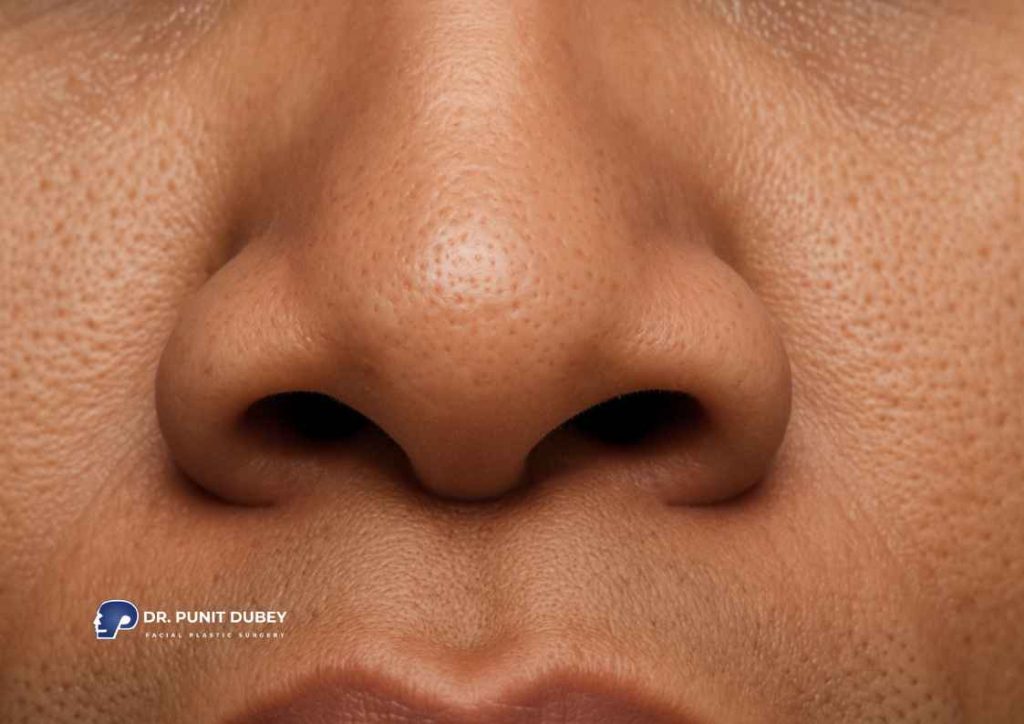
Think of it like tailoring a suit: one alteration improves the fit, but multiple adjustments make it flawless.
Ideal Candidates for Alarplasty Surgery
Alarplasty could be a suitable choice for you if certain criteria apply:
- You have flared or wide nostrils
- Your nasal base appears broad in photos or face-on
- You want to refine your nose without a full rhinoplasty
- Your nostrils appear asymmetrical
- You are medically fit and understand what results to expect realistically
It’s also suitable for people seeking ethnic nose refinement while preserving their natural features. Alarplasty can be performed as a standalone procedure or alongside rhinoplasty and tip plasty for complete nasal harmony.
Quick Tip: If your primary concern is nostril width — not the bridge or tip — alarplasty may be all you need.
The Process of Alarplasty Surgery in Delhi
Considering alarplasty? Here’s a step-by-step look at what to expect when undergoing alar base reduction surgery in Delhi.
Initial Consultation
Your journey starts with a detailed evaluation:
- Facial proportions and nostril shape are assessed
- Dr. Punit will carefully evaluate your nasal cosmetic objectives and health background
- The surgeon explains whether you need alarplasty only or in combination with other procedures like tip plasty
This consultation often includes imaging to preview your before-and-after results.
Pre-Surgery Preparations
Before the surgery:
- Avoid blood-thinning medications and smoking
- Get necessary blood tests if advised
You’ll be given detailed instructions before surgery, including what to eat or avoid, how to maintain hygiene, and which medications to take or pause.
The procedure is typically done under local anesthesia, sometimes with sedation.
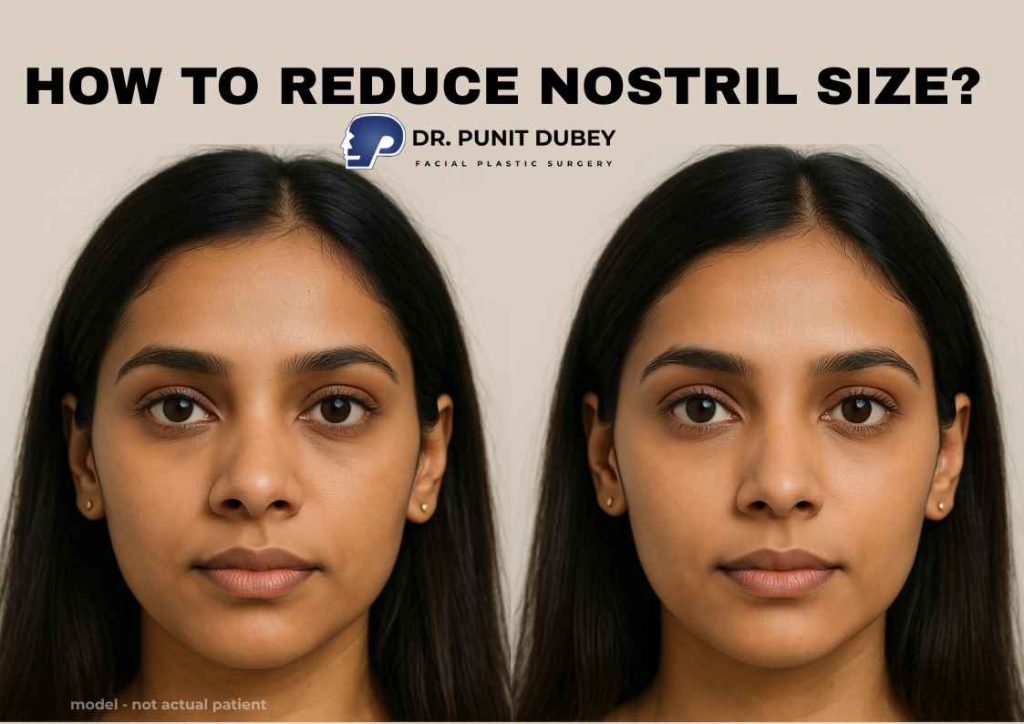
Alarplasty Surgery Process
- Small incisions are made at the alar base (where nostrils meet the cheeks)
- A wedge of soft tissue is removed to reduce nostril width
- Sutures are strategically hidden in natural skin folds to ensure they’re barely noticeable
- The surgery typically takes around half an hour to 60 minutes to perform, depending on individual anatomy and technique used.
As a same-day procedure, alarplasty doesn’t require hospitalization — you can leave the clinic shortly after the operation.
Bonus: When done by a skilled facial plastic surgeon, the alarplasty scar becomes nearly invisible over time.
Alarplasty Recovery Time
Recovery after alarplasty is generally smooth and quick — most patients return to their routine within 5 to 7 days.
Here’s what to expect:
- Minor puffiness and discoloration around the nostrils may appear for several days
- Sutures are typically taken out within 5 to 7 days post-op
- Minor scabbing may occur but fades gradually
- It’s recommended to refrain from heavy physical activity for two weeks following the surgery
Most swelling settles in 2–3 weeks, and final results are visible in 1–3 months. With expert technique, the incision marks from alarplasty blend seamlessly into the nose’s natural contours over time.
Tip: Follow your surgeon’s aftercare instructions closely for faster healing and minimal scarring.
Benefits of Alarplasty
Alarplasty offers subtle yet powerful improvements in nasal aesthetics. Here’s why it’s gaining popularity:
- Reduces wide or flared nostrils
- Enhances facial symmetry and proportion
- Leaves minimal visible scarring
- Quick procedure with short recovery time
- Can be done without full rhinoplasty
- Boosts confidence and profile aesthetics
It’s a perfect choice for patients who want refinement without major surgery — a small change that creates a big difference.
Alarplasty Side Effects
Like any cosmetic procedure, alarplasty carries some potential side effects — most of which are temporary and manageable with proper care.
Common Side Effects:
- Mild swelling, bruising, or tenderness
- Temporary numbness at the incision site
- Small scabs or redness at the stitch lines
- Minor asymmetry in early healing phase
Less Common Risks:
- Noticeable alarplasty scars (usually due to poor technique or improper healing)
- Infection (rare when aftercare is followed)
- Overcorrection or under-correction of nostrils
Pro Tip: Choosing the right surgeon significantly reduces the risk of poor outcomes or a bad alarplasty scar.
Picking the Best Alarplasty Surgeon in India
When selecting a surgeon, look for:
- Specialized training in facial plastic surgery or rhinoplasty procedures
- A portfolio of alarplasty before and after results
- Positive patient reviews and testimonials
- Knowledge of alarplasty techniques (classic, wedge, nostril sill excision, etc.)
- Use of minimally invasive methods to reduce scars
Choosing someone with experience in both cosmetic and ethnic nose surgery ensures you get personalized results that enhance — not erase — your natural beauty.
Why Choose Alarplasty in Delhi with Dr. Punit Dubey?
When it comes to delicate procedures like alar base reduction, precision, artistry, and experience matter. That’s why patients from across India — and even abroad — trust Dr. Punit Dubey for alarplasty in Delhi.
Pioneer in Ultrasonic, Preservation & Hybrid Rhinoplasty Techniques
Dr. Punit Dubey has trained under some of the world’s leading rhinoplasty experts, mastering advanced techniques like:
- Ultrasonic rhinoplasty for bone sculpting without trauma
- Preservation rhinoplasty to maintain natural anatomy
- Hybrid rhinoplasty is a new concept which combines preservation and structural techniques for highly individualized results
His experience in both open and closed alarplasty ensures natural-looking nostril refinement with minimal scars.

One of the Best Rhinoplasty Surgeon in Delhi for Balanced Aesthetic Results
Dr. Punit Dubey brings years of dedicated experience in facial aesthetics and nasal surgery.
- Customized surgical plans for every nose type
- A track record of refined, symmetric, scar-minimizing results
- Attention to subtle ethnic features and cultural aesthetics
You don’t just get surgery — you get a nose that fits your face, personality, and proportions.
Cost-Effectiveness Compared to Other Cities
Delhi offers the perfect balance:
- Access to top-tier medical expertise
- World-class facilities
- At far more affordable rates than metros like Mumbai or international locations
Patients also save on travel, hospital stay, and consultation fees — without compromising quality.
Alarplasty Cost in India
One of the most attractive aspects of alarplasty in India is its affordability without compromising on quality. Whether you’re opting for a standalone nostril reduction or combining it with rhinoplasty, the procedure remains cost-effective.
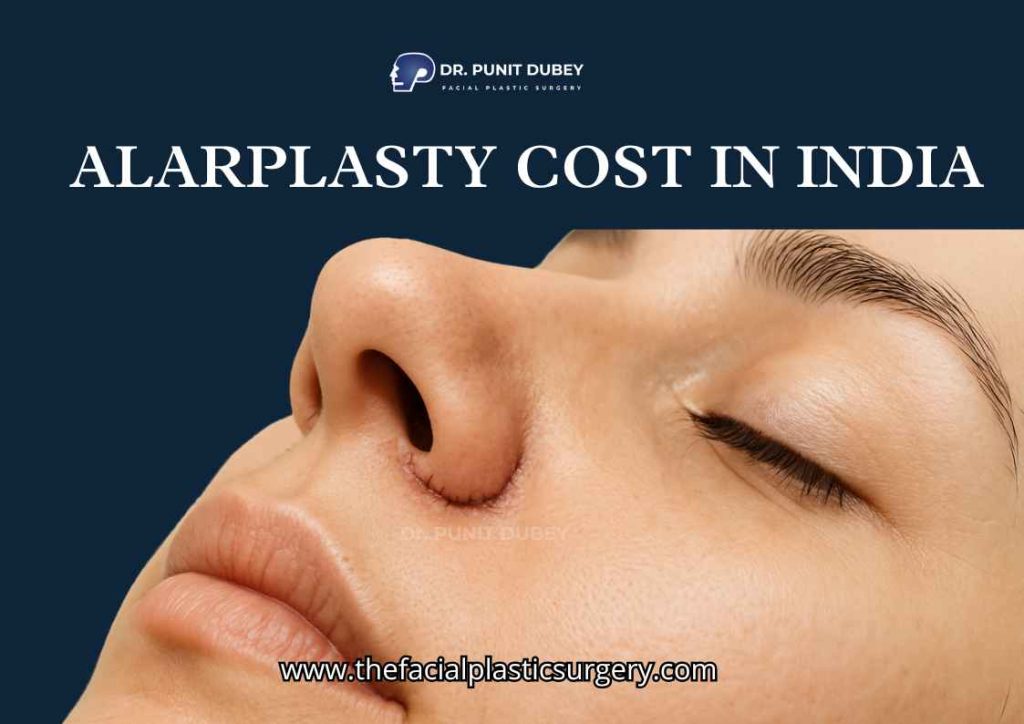
Average Alarplasty Cost in India:
- ₹35,000 to ₹75,000 for alarplasty alone
- ₹85,000 to ₹1,50,000+ when combined with tip plasty or rhinoplasty
Alarplasty cost in Delhi generally begins at ₹35,000, though it may vary based on the surgeon’s experience and clinic facilities.
What Affects the Cost?
- Surgeon’s expertise and credentials
- Location and clinic reputation
- Type of technique used (open vs. closed)
- Whether it’s a standalone alarplasty or part of a larger nasal reshaping plan
- Use of custom surgical techniques for ethnic or revision cases
Compared to the West, where alarplasty can cost over $3,000–$5,000, India offers world-class results at a fraction of the price.
Alarplasty Before and After: Real-Life Transformations
One of the best ways to understand the power of alarplasty is by seeing actual before-and-after results. Even a small reduction in nostril width can create a significant improvement in overall facial balance.
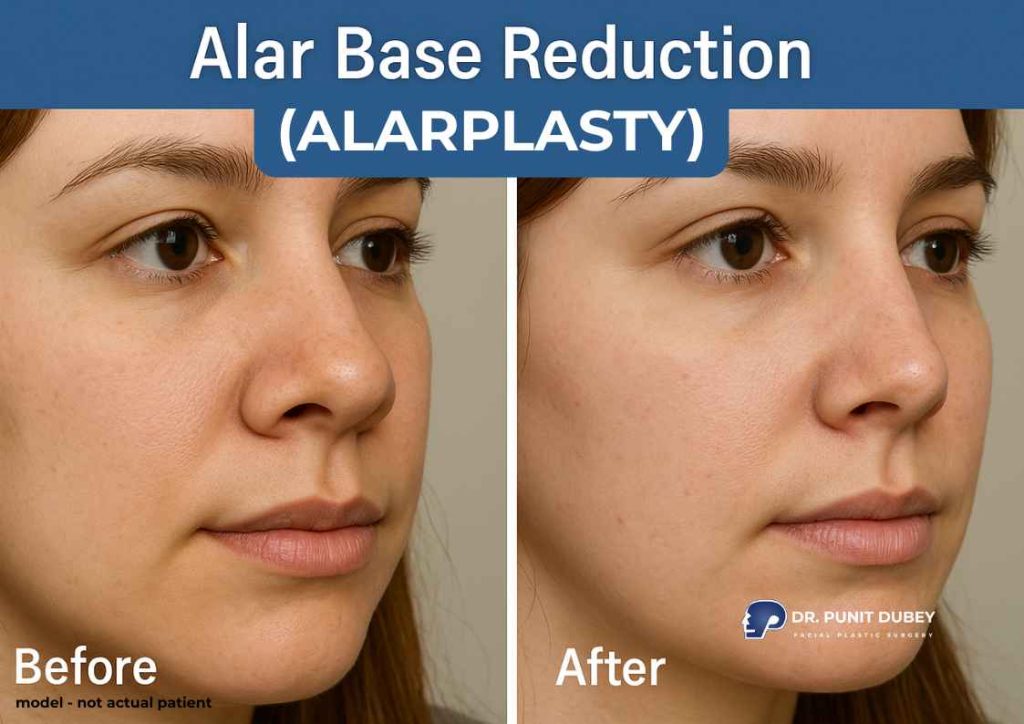
What Changes Can You Expect?
- Narrower nostrils
- Reduced nasal flare while smiling
- Improved balance and proportion between both nostrils
- A more refined and proportionate nose base
Results Timeline:
- Visible improvement in 1–2 weeks after swelling subsides
- Final results in 1–3 months
- Over time, alarplasty scars lighten and are barely visible thanks to strategic incision placement
Whether it’s subtle or more defined, the transformation often leads to a more confident self-image — with or without makeup, from every angle.
Many patients say it’s the small change that made the biggest difference in their selfies and close-up portraits.
FAQs on Alarplasty in India
How to reduce nostril size without rhinoplasty?
Alarplasty is the most effective way to reduce nostril size without undergoing full rhinoplasty. It targets the alar base directly, offering a focused, scar-minimizing solution.
How does alarplasty differ from a full rhinoplasty procedure?
Alarplasty focuses only on reducing the nostril width or flare, while rhinoplasty reshapes the internal structure, nasal bridge, and tip. They can be done separately or together for enhanced results.
Is alarplasty permanent?
Yes, alarplasty provides permanent results. Once the excess tissue is removed and healed, the nostrils retain their new shape long term.
Is alarplasty safe?
When performed by a qualified facial plastic surgeon, alarplasty is a safe and predictable procedure with minimal complications. Risks like infection or scarring are rare and manageable.
How much does alarplasty cost in Delhi?
The price of alarplasty in Delhi usually falls between ₹35,000 and ₹75,000. Factors such as surgical difficulty and the experience level of the surgeon influence the final cost. If performed alongside tip plasty or rhinoplasty, the total expense may be higher.
Does alarplasty leave a visible scar?
Scars are minimal and strategically placed in the natural creases of the nose. With proper care and surgical precision, alarplasty scars fade well over time.
Can I combine alarplasty with tip plasty?
Absolutely. Many patients benefit from a combined approach — narrowing the nostrils (alarplasty) while refining the nasal tip (tip plasty) for balanced, natural-looking results.
How long is the recovery after alarplasty?
Most patients recover in 5 to 7 days, with swelling and minor discomfort resolving within two weeks. Final results become clear within a few months.
9. What is the difference between alarplasty vs rhinoplasty?
Alarplasty and rhinoplasty are two different nose surgeries targeting separate parts of nasal anatomy.
Alarplasty focuses specifically on reshaping the nostrils — it narrows a wide nasal base or reduces nostril flare. Alarplasty, by contrast, focuses only on narrowing the nostrils without modifying the bridge or nasal tip.
Rhinoplasty is a broader procedure designed to refine multiple nasal components, including the bridge, tip, septum, and occasionally the nostrils. It not only enhances the nose’s appearance but can also correct functional issues like breathing difficulties.
Think of it this way: if your goal is limited to nostril refinement, alarplasty is sufficient. But if you need broader corrections — like smoothing a hump, straightening the nose, or lifting the tip — then rhinoplasty is the right approach.

